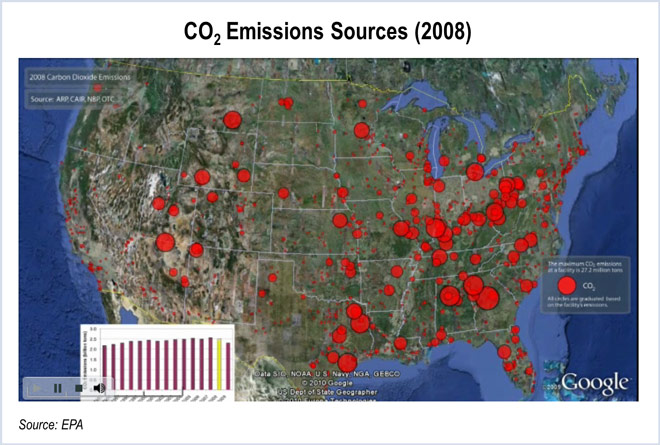By Chris O’Malley
Cap-and-trade, appealing to economists but anathema to most in Congress, is likely to be a core compliance plan for many states under the Environmental Protection Agency’s final version of the Clean Power Plan.
“Trading itself got a lot more prominent than” in the draft plan, said Doug Scott, vice president of strategic initiatives at the Great Plains Institute and a former Illinois Commerce Commissioner.
Trading would set a price on carbon much like the cap-and-trade program that helped reduce compliance costs with acid rain regulations in the 1990s and the Waxman-Markey CO2 plan that died in Congress in 2010.
While at least 40 states have been talking about some sort of trading collaboration toward meeting their carbon-reduction mandates, EPA’s initial proposal in mid-2014 set rate-based goals measured in pounds of CO2 per megawatt-hour.
Last fall, EPA provided technical advice explaining how to translate rate-based goals to mass-based equivalents that measure total carbon emissions in metric tons — a measurement more conducive to multistate trading.
The final rule goes a step further and “reduces confusion and ambiguity” for states contemplating trading, said Minnesota Public Utilities Commissioner Nancy Lange.
Essentially, the final rule “sets out elements you need to have for a trading-ready plan,” Lange added.
“I think you’ll find EPA is not only recognizing but embracing trading [plans],” Scott said.
Uncertainty Remains for Clean Power Plan
But Scott and Lange said that how many and which states will make carbon allowance trading a big part of compliance is impossible to say this early into the game.
For one thing, the final rule turned many states’ preliminary compliance planning upside down. EPA in its final rule loosened — or in many cases tightened — carbon-reduction targets in each state.
Kentucky is reeling from the final rule, which is 27% more stringent than the draft rule. Indiana and West Virginia, which also generate a big portion of power from coal, are facing carbon reductions that are 19% more stringent than before.
In addition to having to make big changes to their compliance modeling, some states face uncertain outcomes as their elected leaders vow to fight EPA in court.
The Indiana Department of Environmental Management, for instance, said it is still studying the final rule and doesn’t want to discuss potential options. The agency deferred to Gov. Mike Pence’s office as to how the state is likely to proceed.
Pence has already signaled his intentions. In June, he wrote a letter to President Obama stating that Indiana would not comply unless the rule was significantly changed.
(See related story, SPP, MISO, PJM States Join Opposition to EPA Plan)
‘Trading-ready’ vs. Formal Trading Pacts
Even with such fighting words in many states, Scott predicts state regulators will continue to discuss carbon-allowance trading scenarios in the months ahead.
“There will be a lot of discussions between states individually,” he said, though predicting it might be a year before anything coalesces.
Scott’s Minneapolis-based Great Plains Institute and the Washington-based Bipartisan Policy Center have been providing staffing support on carbon compliance to the Midcontinent States Environmental and Energy Regulators (MSEER), which includes MISO and SPP states, and to the Midwestern Power Sector Collaborative.
A number of meetings have already been held, including a workshop in Detroit in June.
Trading credits or allowances has lots of potential, says Todd Ramey, MISO’s vice president of system operations. “Trading has the benefits of allowing for a level of price transparency folks need to know. In order to monetize your carbon emissions, there needs to be a general understanding of what that value is in real time,” Ramey told the Detroit workshop.
A number of panelists agreed that multistate trading plans that were “trading-ready” were likely more plausible than formal multistate trading agreements. “Nobody has committed to anything in terms of a multistate effort” so far, Lange said.
She said MSEER has a workshop planned for Sept. 16 in Minneapolis that should be a good forum to discuss trading and other compliance scenarios in light of the final rule.
In the meantime, it’s not just Midwest states thinking more intently about trading plans. Scott said the Great Plains Institute also has been helping advise a number of states in the PJM footprint. His group plans to hold a seminar in October in Little Rock.


